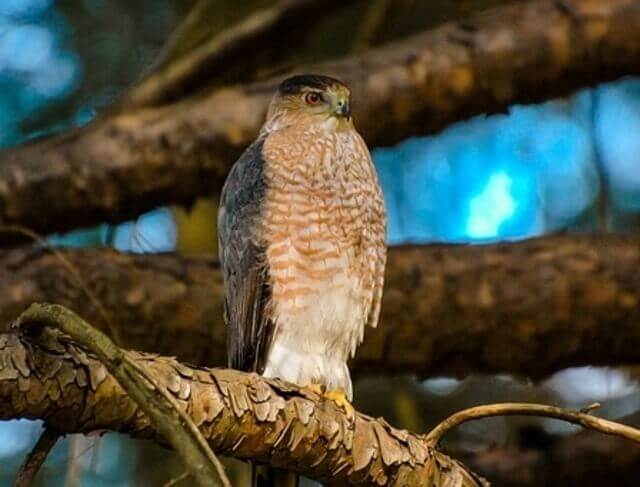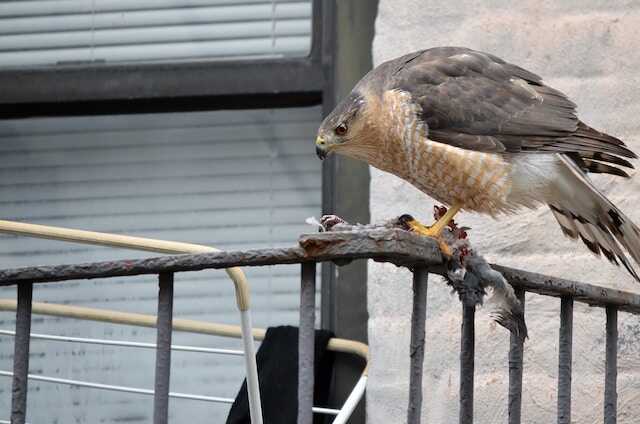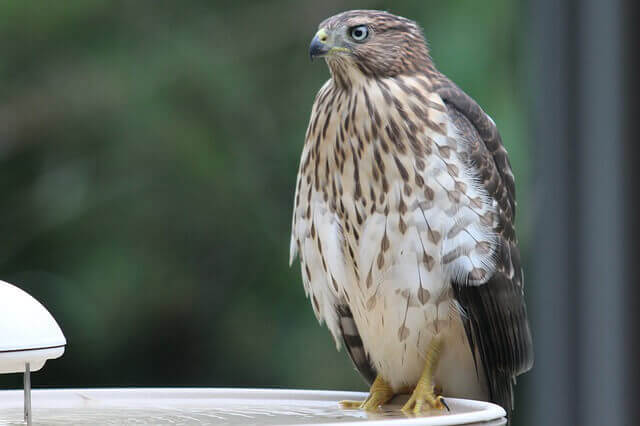Welcome to an exciting journey into the fascinating world of Cooper’s Hawks! In this article, we will delve into the lives of these remarkable birds of prey, uncovering 20 intriguing Cooper’s Hawk fun facts. With a blend of captivating photos and essential information, we’ll explore their diet, incredible speed, conservation status, migration patterns, and much more. Prepare to be amazed as we unveil the hidden wonders of these magnificent raptors!
Table of Contents
- 1 Cooper’s Hawk (Overview)
- 1.1 Cooper’s Hawks soar through the sky at 30 mph.
- 1.2 How the Cooper’s Hawk got its name.
- 1.3 Cooper’s Hawks are named for their hunting style.
- 1.4 Cooper’s Hawks are members of the Accipitridae family.
- 1.5 They inhabit all the United States except for Alaska and Hawaii.
- 1.6 Cooper’s Hawks usually nest in coniferous or deciduous trees.
- 1.7 Cooper’s hawks are monogamous.
- 1.8 Females are 20% larger and 40% heavier than males.
- 1.9 Cooper’s Hawks have an average wingspan of 3 feet.
- 1.10 The Cooper’s Hawk dives at 60 mph to catch prey!
- 1.11 Cooper’s Hawks are diurnal creatures.
- 1.12 Cooper’s hawks can be found across North America.
- 1.13 They build their nests out of twigs and plant material.
- 1.14 They can live up to 12 years in the wild and 20 years in captivity.
- 1.15 A Cooper’s Hawk can eat 12% of its body weight daily.
- 1.16 The Cooper’s Hawk is the 3rd smallest hawk in North America.
- 1.17 Male Cooper’s Hawks are aggressive during mating season.
- 1.18 Nesting Facts
- 2 Author
Cooper’s Hawk (Overview)

| Identification | Cooper’s Hawks are one of the most recognizable birds in North America. They are about the size of a crow, and have a light black cap, a small hooked bill, red eyes, with a bluish-gray upper body. Underneath they are whitish, with a light reddish-brown barring throughout the chin, wing, and breast, gradually fading to white on the lower belly. They have short, rounded wings, and a black and white barring that is visible in flight only. They also have a long tail, yellow legs, and feet. |
|---|---|
| Length | 14.2-15.7″ in. (36-40 cm) |
| Weight | 7.7-14.5 oz. (218-412 g) |
| Wingspan | 24.8-35.8 in. (63-91 cm) |
| Order | Accipitriformes |
| Family | Accipitridae |
| Genus | Accipiter |
| Scientific Name | Accipiter cooperii |
| Range | Breeds in North America (USA & Canada), and migrates to Central America for the winter. |
| Habitat | They mainly live in woodlands or forests but will also inhabit areas near rivers, fields, wetlands, farmlands, suburbs or even towns if food is plentiful there. |
| Diet | Small mammals such as rabbits, squirrels, chipmunks, mice, rats, and fish. |
| Worldwide Population | 850,000 individuals. |
| Conservation Status | Listed Least Concern (Population is increasing). |
Cooper’s Hawks soar through the sky at 30 mph.
These raptors typically fly at cruising speeds of approximately 30 to 40 miles per hour. When they spot prey from a distance, Cooper’s hawks will soar into a long glide and then accelerate through the sky to catch their meal with their talons.
How the Cooper’s Hawk got its name.
Cooper’s Hawks were first named by a French ornithologist named Charles Lucien Bonaparte, to honor his friend William Cooper, in 1828. The two met when Cooper was teaching the Emperor of France how to hunt birds and animals on their hunting grounds at Fontainebleau.
Cooper’s Hawks are named for their hunting style.
These hawks are named for their hunting style: they perch on trees or poles and wait for prey to pass by before swooping down in a short arc and grabbing it with their talons. This technique, called “hawking,” gives them an advantage over other birds of prey that rely on speed to catch prey.
Cooper’s Hawks are members of the Accipitridae family.
Cooper’s Hawks belong to the Accipitridae family, a distinguished group that also encompasses formidable raptors like eagles and ospreys.
They inhabit all the United States except for Alaska and Hawaii.
The Cooper’s Hawk is the only bird of prey that lives in all 50 states, except for Alaska and Hawaii. They are usually seen perching on telephone poles or other tall structures while hunting for rodents such as squirrels, rats, mice, and gophers. Inhabit many types of human-built structures as well. For example: abandoned buildings; billboards; bridges; utility poles; and chimneys are just some examples of man-made places where these birds have been spotted living or roosting.
Cooper’s Hawks usually nest in coniferous or deciduous trees.
Cooper’s hawks commonly choose their nesting sites among the branches of coniferous or deciduous trees. These strategic locations are often in open areas, close to vital water sources like rivers, lakes, or wetlands.
Cooper’s hawks are monogamous.
Did you know that Cooper’s hawks are monogamous? This means that they only mate with one partner for life. The birds share food with each other, as well as incubate eggs together, and feed nestlings cooperatively. They hunt together, and defend their territory together, Cooper’s hawks will usually only seek out a new partner if one of the partners dies.
Females are 20% larger and 40% heavier than males.
The female Cooper’s hawk outpaces the male in size and weight, boasting a 20% larger frame and a 40% heavier build. Males usually tip the scales at 215 to 390 g (7.6 to 13.8 oz), whereas females range from 305.8 to 701 g (0.674 to 1.545 lb).
Cooper’s Hawks have an average wingspan of 3 feet.
The Cooper’s Hawk, a formidable bird of prey, possesses a wingspan that averages 3 feet, placing it in the same league as other large hawks like the Red-tailed Hawk and Broad-winged Hawk.
The Cooper’s Hawk dives at 60 mph to catch prey!
Cooper’s Hawks will typically perch on a high spot to watch for prey below them, then dive straight down at speeds over 60 miles per hour to catch their victim. This process often takes less than 10 seconds from the time it first spots its prey until it captures it.
Cooper’s Hawks are diurnal creatures.
Cooper’s Hawks hunt during daylight hours because they are diurnal creatures. They use the heat of the sun to their advantage when hunting prey, which helps them see more clearly and identify possible food sources more easily. In general, Cooper’s Hawks will eat almost anything from insects to small mammals like mice or squirrels but have been observed as eating smaller birds too.
Cooper’s hawks can be found across North America.
While they can be spotted in numerous states and provinces across North America, Cooper’s Hawks predominantly inhabit regions characterized by dense forest cover, with significant populations in states like Florida and California.

They build their nests out of twigs and plant material.
Their nests are constructed by the female with twigs, bark, pine needles and other plant material, usually in trees or on cliff ledges. These hawks will also occasionally use man-made structures such as bridges for nesting sites but will also use nest boxes that have been erected for them by humans. They also choose a tree that has plenty of cover, so it will be less likely to be spotted by predators.
They can live up to 12 years in the wild and 20 years in captivity.
In the wild, Cooper’s hawks typically have a lifespan of around 12 years, yet under proper care in captivity, they can thrive for up to 20 years. In captivity, they are often bred and raised for falconry or kept as pets.
A Cooper’s Hawk can eat 12% of its body weight daily.
A Cooper’s Hawk can eat an amount of food equivalent to 12% of its body weight. This means that if it weighs 400 grams, it can eat 48 grams worth of food in a day!
The Cooper’s Hawk is the 3rd smallest hawk in North America.
The Cooper’s Hawk is the 3rd smallest hawk in North America. The average size of a male Cooper’s Hawk is 14 -18″ inches tall and weighing about 10-12 ounces. Females are larger, at 17-20″ inches and 1-1.2 pounds on average. They have a wingspan of about 24.5-35.5″ inches, which makes them slightly larger than the other two smallest hawks, the Sharp Shinned Hawk, and the Sparrow Hawk (American Kestrel).
Male Cooper’s Hawks are aggressive during mating season.
Male Cooper’s Hawks are aggressive during mating season. During this time, it can be difficult to get near them. This aggression can be seen as they patrol their territory and harass other males, or females, who dare to enter their territory. They will also engage in physical violence with other males such as wing wrestling, locking talons, and pushing each other off the perch.

Nesting Facts
Cooper’s Hawks (Accipiter cooperii) are known for their preference for nesting in wooded areas, particularly in deciduous and mixed forests. Their choice of nesting location is influenced by several key factors that contribute to their reproductive success. Here’s some information:
- Nesting Period: Mid-March & late May (depends on location)
- Number of Broods Yearly: 1 brood
- Clutch Size: 2 – 6 eggs
- Incubation Duration: 30-35 days
- Nestling Duration: 28-35 days
- Egg Color: Light blue or whitish blue.
- Egg Length: 1.8-2.0″ in. (4.5-5.0 cm)
- Egg Width: 1.3-1.6″ in. (3.4-4.1)
- Wooded Environments: Cooper’s Hawks are commonly found in woodlands, where they can take advantage of the dense canopy and diverse vegetation for cover and hunting opportunities. These habitats offer protection from predators and ample food sources, primarily consisting of small to medium-sized birds.
- Nesting Height: These raptors often choose nest sites in trees, typically within the canopy, although they can occasionally nest at lower heights. They construct their nests in the crooks of tree branches or against the trunk, usually anywhere from 20 to 50 feet above the ground. This elevated location provides both concealment and a vantage point for hunting.
- Nest Structure: Cooper’s Hawk nests are built with sticks and twigs, forming a relatively flat platform that serves as a foundation for the eggs and chicks. The female is primarily responsible for nest construction, while the male assists by bringing materials. Over time, they may reuse and expand the same nest site for multiple breeding seasons.
- Cover and Concealment: Nesting sites are often strategically chosen to provide good visibility of the surroundings while maintaining some level of concealment. The hawks prefer locations that offer a degree of seclusion, minimizing disturbances from potential threats.
- Territorial Behavior: Cooper’s Hawks are territorial during the breeding season, defending their nesting area against intruders, including other Cooper’s Hawks. This territorial behavior helps ensure the safety and resources necessary for successful reproduction.
- Nest Appearance: Cooper’s Hawk nests are relatively large and bulky structures, typically measuring around 20-30 inches in diameter. They are composed of twigs, sticks, and branches, often lined with finer materials such as leaves, bark, and moss. Over time, the nest can become quite substantial, as the hawks may reuse it for several breeding seasons, adding more materials each year.
- Egg Laying: The female Cooper’s Hawk typically lays a clutch of 2 to 6 eggs in the nest, with each egg being about the size of a walnut. These eggs are bluish-gray in color and speckled with brown markings, providing camouflage within the nest.
- Incubation Period: After egg laying, the female incubates the eggs for approximately 30 to 35 days. During this time, she rarely leaves the nest, relying on the male to bring her food. The male’s role in providing sustenance is crucial for the female’s ability to incubate effectively.
- Chick Development: Once the eggs hatch, the chicks are altricial, meaning they are born in a helpless state and require extensive care from their parents. Both the male and female cooperatively feed the chicks, bringing them a diet consisting mainly of small birds and mammals.
- Fledging: Young Cooper’s Hawks fledge, or leave the nest, at around 4 to 5 weeks of age. After fledging, they continue to be fed by their parents for several more weeks as they learn to hunt and become independent.




